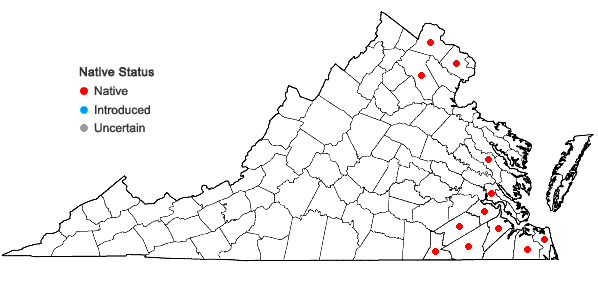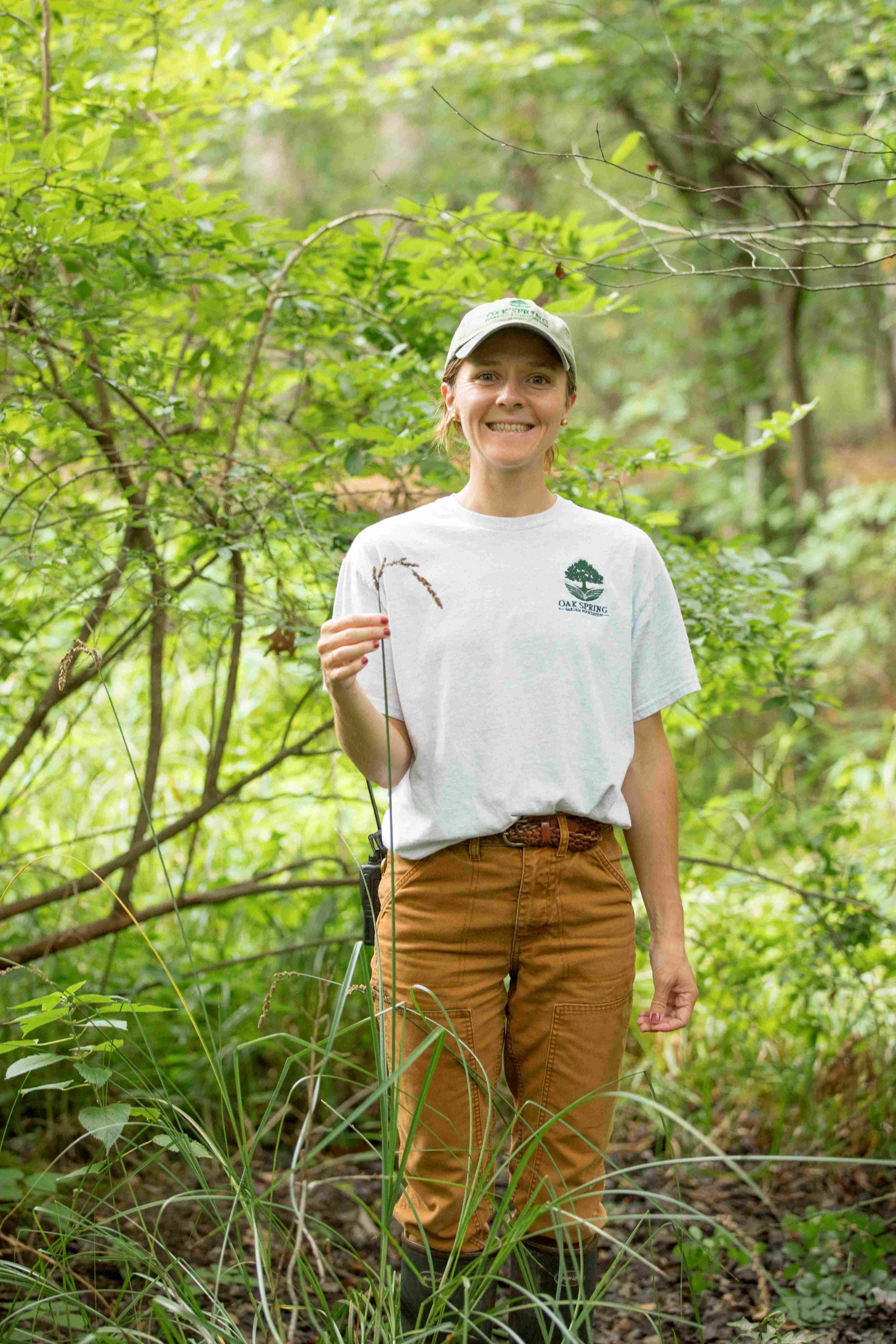Hiding in Plain Sight: Exciting Plants Found at Oak Spring
OSGF
In July of this year, our Head of Biodiversity Conservation, Charlotte Lorick made some exciting finds: Cypress-knee sedge (Carex decomposita) and false hop sedge (Carex lupuliformis) are two incredibly rare species in the state, with the Virginia Department of Conservation and Recreation (DCR) listing them as at highest risk of being extirpated. This was the product of our Biodiversity Conservation team's ongoing efforts to compile a comprehensive snapshot of the species diversity on the property.
Read on to learn more about the plants and communities previously unknown since the formation of Oak Spring.
The small yellow dot marks the spot for Oak Spring among the physiographic provinces.
Oak Spring sits in the Northern Piedmont physiographic province but is in close proximity to the northernmost reaches of the Blue Ridge mountains, and the nearby Ridge and Valley region. Shaped by a geologic history of colliding tectonic plates and years of erosion, the natural communities present today were laid out from this storied geologic past.
Climatic conditions some ~10,000 years ago also played a crucial role in creating unique deposits of plant communities over time throughout the piedmont region of Virginia. Oak Spring exhibits a mix of mostly open pastures and old fields bookended by small sections of oak hickory forests – all of which are not uncommon in our area of the piedmont. However, when Charlotte Lorick, our head of Biodiversity Conservation, was surveying Rokeby woods, she discovered, to her excitement and amazement, a globally rare plant community right here at Oak Spring.
In our story, the particular community she found is a Piedmont upland depression swamp. These areas are shallow and flood seasonally and the typical plant makeup consists of willow oaks (Quercus phellos) and shrubs like blackhaw (Viburnum prunifolium). According to the Virginia Natural Heritage Program at DCR, who documented and characterized these plant communities throughout VA, these upland depression swamps are relatively uncommon though certainly not unusual or rare. However, the Oak Spring depression swamp has a particularly rare assemblage of plant species that puts it on the map as not only a rare and imperiled plant community in Virginia but globally as well.
“I became interested in this area at Oak Spring as it certainly stood out as unique compared to the rest of the landscape…even just at first glance. But I never in my wildest dreams expected to find some of the plants that I found!”
This spring, as Charlotte was conducting vegetation surveys in this plant community, she keyed out a species of sedge (grass-like plants with angular, non-hollow stems) that was designated as critically imperiled in Virginia with estimated fewer than 5 populations left in the state. She immediately wrote to state botanist and Carex expert Gary Fleming at DCR, to tell him about her find and ask for verification.
She wrote in her email:
“ I’m trying to not get too excited but no matter how I look at it, I can’t seem to find anything else it could be. In the cool swamp depression at OSGF I found lots of what I think is Carex decomposita. It checks out with every part of the description. I realize that it’s super rare (and unlikely)…but wow wouldn’t that be something if it is!? So I couldn’t wait to email you to see what you thought. It’s certainly the most unique part of the property, a completely different plant community than anywhere else…”
And after a site visit and enthusiastic response from Gary, the species identification was verified.
Carex decomposita “Cypress-knee sedge”
Cypress-knee sedge is somewhat of an epiphyte, growing, as indicated in the common name, on the knees of bald cypress trees (Taxodium distichum) or on other wood. It also can be found perched on the water line of other submerged logs or wood.




Botanists at DCR– who collect data throughout the state to better understand where to place conservation priorities–use a ranking system both globally and state-wide for plants, animals and natural communities based on a number of factors. Primarily how rare a species is in a given area. In the case of Carex decomposita, it was listed as critically impaired (S1) meaning that the recorded number of plants is so low in the state, there’s cause for concern.
One reason for this, as is the tragic plight of so many vulnerable natural areas, is human impact. Continued land development and wetland drainage has severely reduced the presence of upland depression swamps, not only in Virginia but elsewhere in the US. As a result, species like the cypress-knee sedge which are highly sensitive to changes in the water level become less common or are wiped out altogether.
It’s precisely their rarity that makes this news so exciting. What’s more is the sheer number of plants found– over 200 in total! This sedge along with the presence of high bush blueberry (Vaccinium fuscatum), Eastern mannagrass (Glyceria septentrionalis) among other notable species have meant this community of plants is even more unusual and rare than a typical depression swamp.
To pile on even more excitement, we found in the swamp not one rare sedge, but two!
Carex lupuliformis “False hop sedge”
Carex lupuliformis is another sedge found in wet, mucky sites. Like its relative, cypress-knee sedge, false hop sedge is critically imperiled in Virginia and very susceptible to habitat changes. The common name is in reference to the swollen spikelets which, some say, resemble the fruit of Humulus lupulus, or hops vine.
With these discoveries comes opportunities as news of the exciting two species is shared with other conservation partners both within the region and globally. In fact, projects are already being developed with professors at Virginia Tech to explore more of the natural history of the site, including looking at radiocarbon isotopes, fire history, and possibly even climate history. These studies can help us understand more about the land history and provide a more exact picture of how old the Rokeby swamp is. We are also contributing to research on the genetic diversity of Carex lupuliformis across its range from the US into Canada.
This event at OSGF put this depression swamp on record with Virginia as being worthy of the highest level of biodiversity protection and that is exactly what OSGF plans to do.
But for Charlotte, another important takeaway from this discovery is that opportunities to become a crucial part of plant conservation might be everywhere.
As Charlotte shares, “this unique and imperiled plant community has been hiding here at OSGF for, as far as we know, hundreds of years. Imagine what else could be discovered in backyards and private properties throughout the region. Opportunities to conserve and protect important plant communities might be available to all of us – we just need to start looking!”
Thank you to Charlotte Lorick for her time and insights on this blogpost. Photos are by Charlotte and Sarah Goolishian.
References:
Morse, L. “Carex Decomposita.” NatureServe Explorer, NatureServe, 2024, explorer.natureserve.org/Taxon/ELEMENT_GLOBAL.2.154855/Carex_decomposita.
Ostile, W.R. ” NatureServe Explorer, NatureServe, 2024, https://explorer.natureserve.org/Taxon/ELEMENT_GLOBAL.2.155684/Carex_lupuliformis
“Overview of the Physiography and Vegetation in Virginia.”, Virginia Dept. of Conservation and Recreation, Division of Natural Heritage, Mar. 2021, www.dcr.virginia.gov/natural-heritage/natural-communities/document/ncoverviewphys-veg.pdf.
“Sedges.” Missouri Department of Conservation, mdc.mo.gov/discover-nature/field-guide/sedges. Accessed Oct. 2024.






